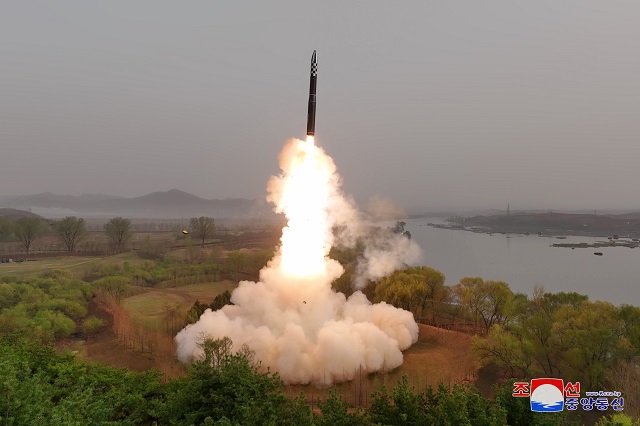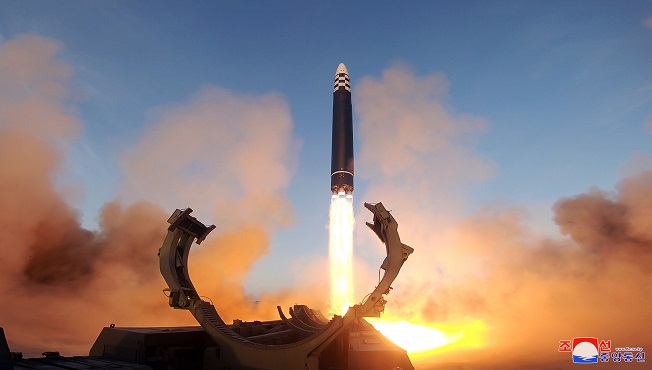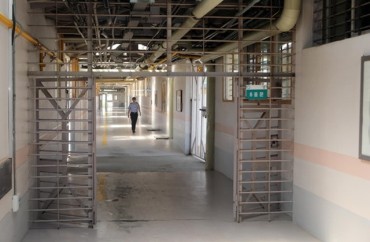
North Korea’s new Hwasong-18 intercontinental ballistic missile is test-launched on April 13, 2023, in this photo released by the North’s official Korean Central News Agency. (Yonhap)
SEOUL, April 14 (Korea Bizwire) — North Korea’s first test launch this week of a purportedly solid-fuel intercontinental ballistic missile (ICBM) appears intended to secure the ability for a surprise strike and complicate tightening South Korea-U.S. deterrence efforts, analysts said Friday.
The North’s official Korean Central News Agency confirmed the country fired a Hwasong-18 ICBM in Thursday’s test to confirm the performance of the “high-thrust” solid-fuel engines, while portraying its mission as the “powerful, pivotal and principle” means to defend the nation.
Threats from such a solid-propellant missile stem from the fact that it takes less preparation time to launch than a liquid-fuel system requiring cumbersome prelaunch preparations, such as the injection of fuel, which can be detected and targeted by the allies.
Speculation had already persisted that the North would fire such a solid-fuel rocket as it unveiled a new ICBM — mounted on an 18-wheel transporter, erector, launcher (TEL) — during a military parade in February and tested a “high-thrust” solid-fuel rocket motor of 140 ton-force last December.
“Compared with the liquid-fuel missile system, an early detection of a solid-fuel missile launch could be more difficult given the limited time (for the allies) to respond to that,” a security expert said, requesting anonymity.
“I assume the development of the new missile appears designed to negate South Korea’s three-axis defense system and shake America’s deterrence responses,” he added, referring to Seoul’s three-pronged security architecture, including the Kill Chain preemptive strike system.
The Kill Chain system consists of various detection, strike and other assets that would allow the South to launch a preemptive strike if there are clear signs of an imminent North Korean attack in a contingency.
But a solid-fuel ICBM using road-mobile or other hard-to-detect launchers from any part of the North could pose a significant challenge to that preemptive strike formula, analysts said.
Seoul’s defense ministry dismissed as “excessive worry” the view that the Hwasong-18 could negate the South’s Kill Chain system.
“We assess that the test was a mid-stage test-firing for the purpose of developing a solid-fuel long-range ballistic missile, and to complete the development would need additional time and effort,” it said in a statement.
The ministry added that the South Korea military has “evolving” capabilities against North Korean threats, including the real-time detection of targets in the North.

This photo, carried by North Korea’s official Korean Central News Agency on April 11, 2023, shows the North’s leader Kim Jong-un (C) pointing his finger at what appears to be a map of South Korea, while presiding over an enlarged meeting of the Central Military Commission of the ruling Workers’ Party of Korea (WPK) the previous day. (Yonhap)
The testing of the new missile came as Seoul and Washington have been stepping up joint efforts to strengthen the credibility of America’s “extended deterrence,” its commitment to mobilizing the full range of its military capabilities, including nuclear, to defend its ally.
Some observers raised concerns that the North’s advancing capabilities for a surprise attack could undercut the U.S.’ extended deterrence commitment, as its ICBM threats could put American forces at bay should its ally come under attack — a scenario that they fear could lead to a “decoupling of the allies.”
“(North Korean leader Kim Jong-un) would very much like to see the alliance decoupled, because achieving that objective would potentially allow him to dominate the ROK without having to conquer it,” Bruce Bennett, a senior defense analysts at RAND Corp., told Yonhap News via email.
“And fielding an improved ICBM also has that purpose — posing a threat to U.S. cities if the US meets its nuclear umbrella commitments to the ROK,” he added, referring to the South by its official name, the Republic of Korea.
Touching on the potential military utility of the Hwasong-18 ICBM, Bennett said it is “not necessarily true” that the solid-fuel one can be fired much more rapidly than the liquid-fuel ones, like the Hwasong-17 ICBM, and therefore negate the Kill Chain system.
“Yes, a solid-fuel missile has its fuel put into it when it is manufactured, whereas a mobile liquid-fuel missile must usually be lifted into launch position and then fueled,” he said.
“But the Soviets had silo-based liquid fuel ICBMs even in the 1960s that could have been very quickly launched because the missile was always fueled.”
Photos of the Hwasong-18 launch indicated that the newest ICBM uses a “cold-launch” method under which rocket engines ignite shortly after being ejected from a mobile launcher — compared with a “hot-launch” one whereby rocket engines ignite the moment it is launched.
The cold-launch system can help protect the launch platform and surrounding areas from the burst of flames created when a missile is launched, signaling the North’s efforts to modernize the overall launch process, analysts said.

This photo, carried by North Korea’s official Korean Central News Agency (KCNA) on March 17, 2023, shows the North firing a Hwasong-17 intercontinental ballistic missile from the Sunan area in Pyongyang the previous day. (Yonhap)
The latest ICBM launch underscores Pyongyang has been charging ahead with a series of high-stakes defense projects unveiled at the eighth congress of its ruling Workers’ Party in January 2021.
The projects included developing a hypersonic warhead, raising the “hit rates” of missiles with a range of 15,000 kilometers, producing a “super-large” nuclear warhead and developing an ICBM using an “underground or ground solid-fuel engine.”
The North’s push for these defense projects could prove counterproductive, observers said, as they have led the South and the U.S. to strengthen their deterrence efforts as seen in the recent deployments here of high-profile American military assets, such as a nuclear-powered aircraft carrier.
Growing North Korean threats have also created an opening for the South and Japan — long mired in historical and territorial feuds — to move beyond the past and confront their shared security challenges together.
Concerns about the “decoupling” of the South Korea-U.S. alliance could also fade as Washington sees the growing strategic value of its Asian ally in the context of a growing Sino-U.S. rivalry, Nam Chang-hee, professor of international politics at Inha University, said.
(Yonhap)






